
I’m not a fan of the vampire genre. As a general rule, I don’t read vampire stories or watch vampire movies (or zombie or horror). But over the cold winter months, I decided to take a look at Netflix’s new religious horror series, Midnight Mass. In spite of the blood, gore, and violence you would expect in a vampire film, the miniseries (seven one-hour episodes) offers an engaging and thoughtful examination of American religion through the eyes of popular culture.
The Story Line
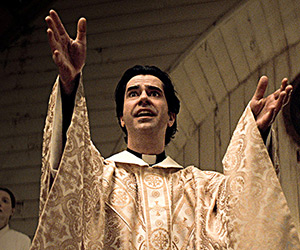
Father Paul Hill
According to Wikipedia, “the plot centers on an isolated island community that experiences supernatural events after the arrival of a mysterious priest.” Soon after the young, charismatic Father Paul Hill arrives in Crockett Island to temporarily fill in for their parish priest (who is on a trip to the Holy Land), strange things begin to occur. Dozens of dead cats wash up on the beach. A paralyzed teenage girl is miraculously healed during a worship service. Elderly residents begin to regain their youthful health. Saint Patrick’s Catholic Parish breaks into a religious revival. People begin to notice that Father Paul looks a lot like a younger version of their longtime aging parish priest. Father Paul begins spiking the congregational Communion wine with real blood. A drug dealer is killed by a violent, bloodsucking winged creature whom Father Paul claims is an angel. In a surreal midnight Mass, Father Paul exhorts the congregation to drink deadly poison so they can die and be resurrected. And then things really begin to get weird!
Rather than explaining the bizarre plotline, engrossing as it may be, I’d like to shift to the real point of this month’s post. The characters of Midnight Mass creatively represent at least four different types of religion that can be found in contemporary America.
Sick Religion
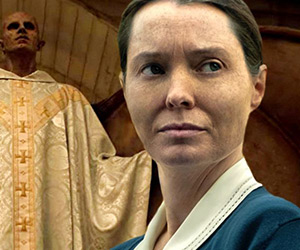
Bev Keane
It probably won’t surprise you that an apocalyptic miniseries about a vampire priest—produced by an atheist ex-altar boy in the Roman Catholic Church—includes a few critiques about religion. In fact, toxic religion abounds in Midnight Mass. This sick religion is best exemplified by Bev Keane, a zealous and overbearing volunteer at Saint Patrick’s church.
Although Father Paul ends up being a semi-sympathetic figure who ultimately regrets his misguided actions, his volunteer assistant, Bev Keane, is completely unredeemable. She’s arrogant, passive-aggressive, sanctimonious, self-righteous, and judgmental. She exhibits no tolerance, no compassion, and no empathy. She weaponizes her faith to attack people she despises, including Muslims and unfaithful church members. Although she can adeptly quote Scripture passages to justify and rationalize her perverse behavior, she conveniently ignores the example, spirit, and teachings of Jesus. Even at the end, when the depth of her depravity is fully revealed and she faces certain destruction, her only response is to deny responsibility and lash out in rage.
In short, Bev represents the many expressions of toxic religion that are rampant in today’s culture. Examples abound, including religion that is abusive, nationalistic, partisan, closed-minded, judgmental, mean-spirited, self-serving, rigid, exclusive, intolerant, arrogant, hateful, antigay, anti-feminist, anti-immigrant, anti-science—and the list goes on and on. There’s no shortage of sick religion in today’s environment. Unfortunately, Bev Keane’s spirit is alive and well in contemporary spiritual America.
Helpful Religion
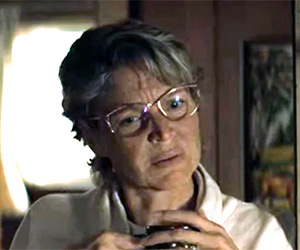
Annie Flynn
Although Midnight Mass offers a scathing critique of sick religion, it doesn’t paint all religious people with the same condemning brush. Throughout the series we also see examples of helpful, healthy, and sympathetic religion.
A good example can be found in Annie Flynn, a devout member of Saint Patrick’s parish who finds solace in her faith. She’s a good mother, willing to forgive and support her son in spite of his spending four years in prison for killing a woman while driving drunk. She’s a good wife, loving and encouraging her husband during his financial and physical struggles. Even after being attacked by a vampire and thus becoming one herself, she resists the overwhelming urge to attack and drink the blood of innocent residents on the island. At the end of the story, after the church members-turned-vampires feel deep remorse for their actions and face imminent demise, she helps them find comfort and hope in “the valley of the shadow of death” by leading them in singing the old hymn, Nearer, My God, to Thee. Other religious characters in the film, including Ali Hassan, the valiant Muslim sheriff who dies with courage, hope, and dignity as he prays to Allah, are also presented in a positive light.
Midnight Mass recognizes that while religion often goes bad, it can also be helpful—offering hope, comfort, guidance, community, and meaning to large numbers of people. Interestingly, some atheists complained that the film was overly generous to religion. That hardly seems the case, given the toxic, violent, blood-filled church and priest-centered faith at the heart of the story. But in spite of its bias against religion, the film is able to nuance religious faith, acknowledging that it includes both life-diminishing and life-giving dimensions.
No Religion
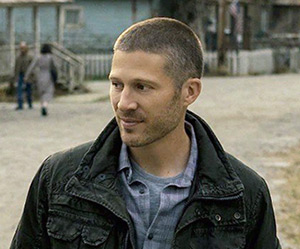
Riley Flynn
Although most residents of Crockett Island affirm religious beliefs, not all of them do. That includes Riley Flynn, a former venture capitalist who served four years in prison for vehicular homicide. He gives up on the Christian faith of his childhood, unable to reconcile the massive suffering in the world with a personal, providential, and loving God. After exploring numerous other religious traditions, Riley finally becomes an atheist.
Riley’s lack of faith is clearly articulated in his response to the question, “What do you think will happen when you die?” Riley responds, “When I die, my body stops functioning. Shuts down. All at once, or gradually, my breathing stops, my heart stops beating. . . . My brain activity ceases and there is nothing left of me. No pain. No memory, no awareness that I ever was. . . . The electricity disperses from my brain till it’s just dead tissue. Meat. Oblivion.”
It should be noted that Riley, in spite of his atheism, and in spite of his horrible mistake of driving while drunk (which he never forgives himself for), is a person of character, values, and ethics. So are other unbelievers in the film, including Sarah Gunning, the village doctor, who also happens to be a lesbian. The film makes a strong argument that nonbelievers are just as ethical (and often more so) than religious persons and that a person can most certainly be “good without God.”
Ambiguous Religion
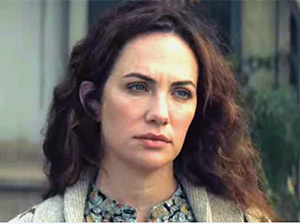
Erin Green
The characters of Midnight Mass don’t all fall into clear-cut religious categories as overly simplified and summarized above. Plenty of people, perhaps most of us, experience a lot of religious ambiguity. That describes the character Erin Green, a schoolteacher on Crockett Island. Over the course of the series, her faith hovers between traditional and nontraditional beliefs. However, at the end of the film, Erin clearly expresses a nonorthodox understanding of religion.
Midnight Mass features three intriguing monologues around the question, “What happens when we die?” The most interesting answer comes from Erin as she lies on the ground, dying from an attack by the winged vampire monster whom Father Paul erroneously believes is an angel. In her final moments of life, she answers the crucial question about life after death by saying to herself:
I am energy . . . and I’m returning home. And it’s like a drop of water falling back into the ocean, of which it’s always been a part. All things . . . a part. All of us . . . a part. You, me and my little girl, and my mother and my father, everyone who’s ever been, every plant, every animal, every atom, every star, every galaxy, all of it. More galaxies in the universe than grains of sand on the beach. And that’s what we’re talking about when we say “God.” . . . There is no time. There is no death. Life is a dream. It’s a wish. Made again and again and again and again and again and again and on into eternity. And I am all of it. I am everything. I am all. I am that I am.
Erin represents the growing number of people in the world today who believe in a natural, evolutionary, universal, life-force/energy-force spirit in the cosmos, of which we all are an integral part, what some authors call “the luminous web” of life. Although this view doesn’t affirm a theistic God, a divine Christ, or institutional religion, it’s a deeply spiritual understanding of life, death, and universal connection. It’s significant, I think, that Erin’s final thoughts are the mysterious and ambiguous words of Yahweh speaking to Moses at the burning bush in the book of Exodus, “I am that I am.”
So there you have it—my take on “vampire theology” as seen in Midnight Mass. I’m not recommending that you watch the series, especially if you dislike horror and gore. In fact, my wife, who only saw a few snippets of the film in passing, emphatically encouraged me to tell you, “Don’t watch it!” However, in spite of the negatives, I found it to be a provocative lens through which several different types of American religious expressions can be viewed, including:
As one reviewer said, “Midnight Mass’s slow boil is a triumph of terror that will leave viewers shaking—and thinking—long after the credits roll.”
I’m certain he is correct. And I’m confident it will be a long time, if ever, before I watch another vampire movie!
 Martin Thielen, retired UMC minister and author of eight books is the creator and author of www.DoubtersParish.com
Martin Thielen, retired UMC minister and author of eight books is the creator and author of www.DoubtersParish.com
Notifications
You can skip to the end and leave a response. Pinging is currently not allowed.